Introducing the AudioCodes Router VoIP Router
Flexibility and mobility give a competitive edge to today's small business. And the new communication technologies provide such a business with a ton of tools that have recently been expensive and complex, and therefore only large organizations with the appropriate staff of specialists could use them. The Internet has firmly entered our lives along with messengers and email, but telephony technologies are developing at a very serious pace, yet the phone is still one of the main and most convenient means of communication. IP-telephony is finding more and more supporters, as compared to a classic phone, it provides much more convenient functionality: an answering machine, a “voice secretary” service, connecting any numbers, including 8-800 hotlines and a lot of other features.
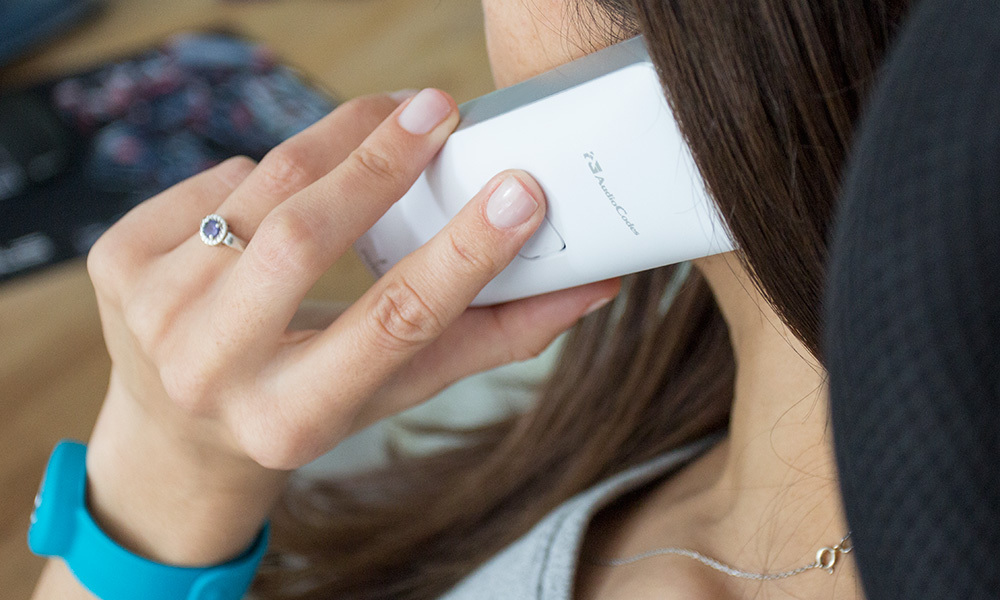
Manufacturers try to keep up with the trends and strive to make life easier for users, which is why interesting solutions are beginning to appear on the market that focus on the SOHO sector and allow organizing all office communications in one place without any problems. We’ll talk about one of the devices that is able to replace the Internet center of the office (or supplement it).
The issue of equipping the office with telephones can be solved in several ways: connecting a landline telephone, equipping employees with mobile phones and IP-telephony. The first method, as a rule, is the most inflexible: modest functionality and loss of numbers when moving; the second is good as an auxiliary, and the third, IP-telephony, with all its advantages, many do not know "how to cook." Indeed, if you connect a conditional wireless router and establish the Internet is a task that most people with a basic understanding of the essence will cope with, then the task of establishing office telephony will seem difficult for an unprepared person. This is because until recently, such equipment was made taking into account customization by a professional, but market trends are such that manufacturers break existing stereotypes. Of course, the “sophisticated” equipment has not gone anywhere, but it remains the prerogative of large companies with expanded functional needs. But the small business market SOHO / SMB requires engineering simple and easy-to-use solutions.
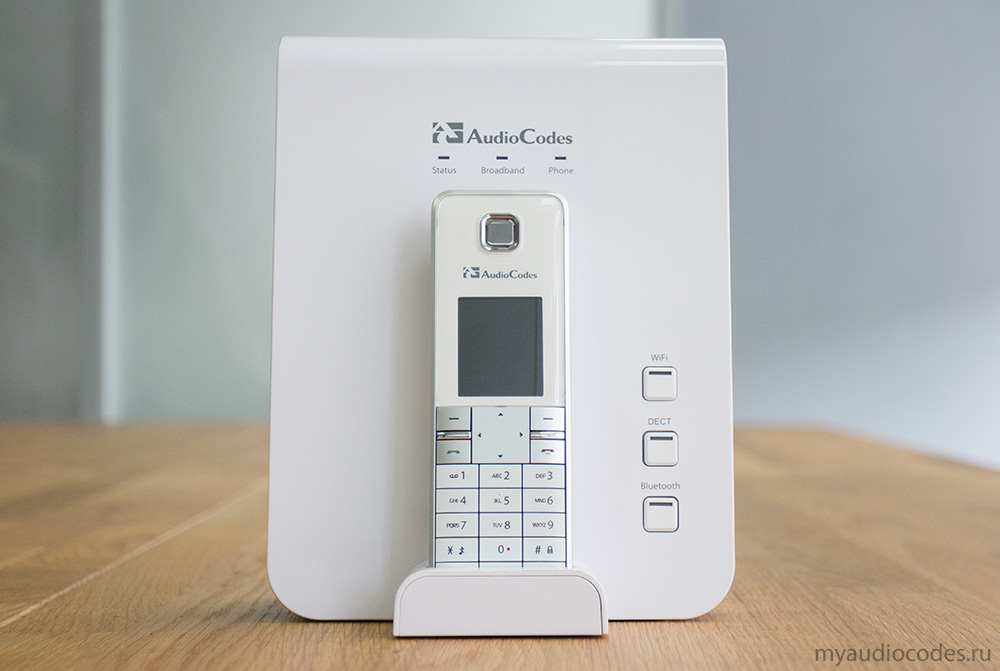
One of these is the AudioCodes Router series of multiservice VoIP routers , in our case, the MP-272DB model , which is also distributed under the Megafon R2 brand . First of all, it is designed to comprehensively replace or supplement the office's Internet center.
As they say, it's easier to see once:
Technically, this is a combination of a classic wireless router with a PBX with a built-in DECT base and two analog ports for connecting ordinary phones. The device can be connected to the Internet in three ways: via an ADSL2 + or VDSL line, through classic Ethernet and using a USB modem for 3G / 4G networks. Not all SOHO routers provide this rich functionality. In the event of a sudden lack of an Internet connection through the main provider, the device will automatically switch to the spare channel via the 3G / 4G network.
Structurally, the device is made in a slightly inclined vertical version made of white plastic with black inserts on the sides, on the front panel of which there is a charging cup for the supplied DECT tube.

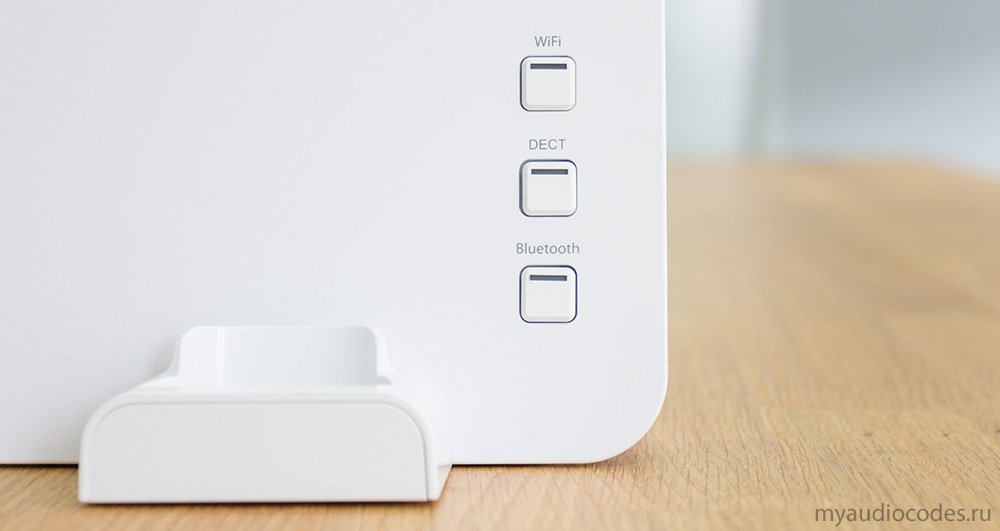
A number of status indicators are located here, including the status of the system, network connection, WiFi, DECT and others. On the bottom of the back of the device there is a power port, Ethernet ports (one for connecting to the Internet and four for LAN devices), xDSL, FXS with an RJ-11 connector and USB. All antennas are inside, no external. The device looks very attractive and the appearance does not spoil the interior.

The device provides full-time support for working from an external battery, which is purchased separately, which will allow you to not be left without communication in case of a sudden power outage in the room. For this, there is a special connector on the rear panel.
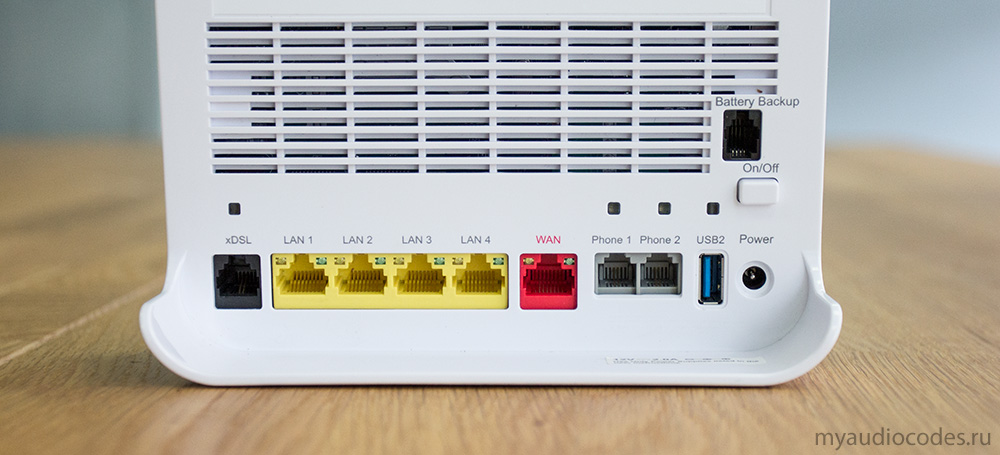
Office users can access the Internet both via a wired connection, for which there are four Fast or Gigabit Ethernet ports on board the device (respectively, 100 or 1000 megabits per second, depending on the model), and using wireless WiFi 802.11b / g / n at speeds up to 300 Mbps (2x2). For the convenience and safety of users, there is support for all common network protocols and solutions: SPI firewall, UPnP, 802.1p / q (VLAN and QoS), multicast (IGMP proxy, snooping), a built-in WiFi access point allows you to organize multiple networks (multiple SSID) and supports WPA / WPA2, WPS, as well as authorization through the browser.
But this is all a description of a typical SOHO router, which is not bad, but still a side feature. Historically, AudioCodes has specialized specifically in IP telephony equipment. The manufacturer went further: in addition to the classic VoIP gateway with two analog FXS ports, the device also has a fully-fledged wireless DECT / GAP base with support for up to five handsets (one in the kit).
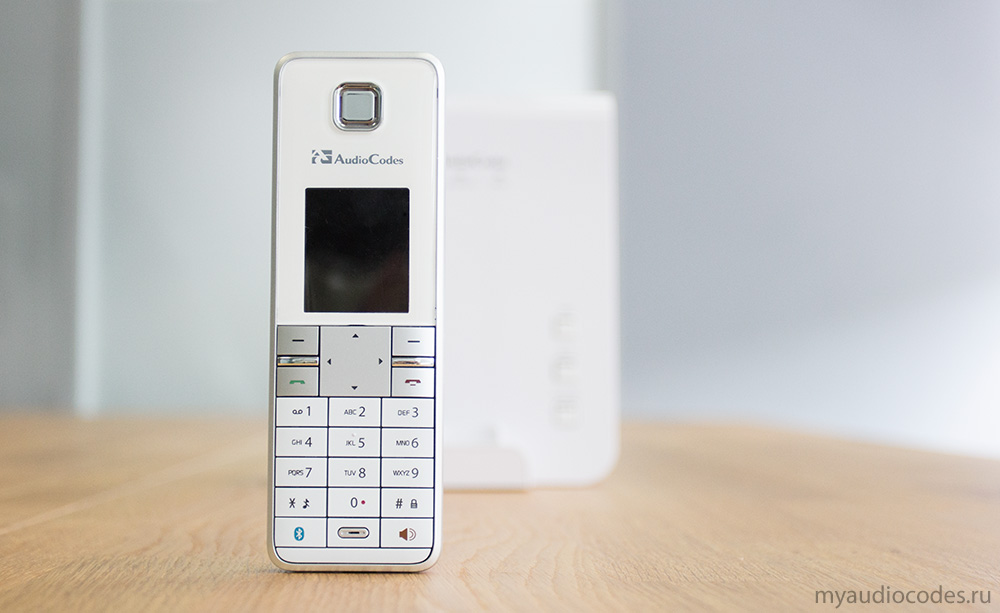
The telephony protocol uses widespread SIP over TCP / UDP and its secure version with TLS encryption. Voice codecs are represented by the list: G.711μ / a-law, G.729A / B, G.723.1, G.722 (for HD VoIP), G722.2 (WB-AMR), as well as fax support. DECT, as stated, supports up to five handsets. The built-in PBX supports 5 DECT subscribers, two analog subscribers via FXS ports and up to 10 registered IP phones. Full support for dial plan, hold, transfer, call forwarding and up to two independent tripartite conferences is also present.
Automatic fax supports the T30, T.38 protocols, in addition there are useful Fax2Mail functions for automatically sending faxes to e-mail and Mail2Fax, working in the opposite direction and able to work with attachments of TXT, PDF, DOC, Excel, Power Point formats of various images.
The included DECT handset is also white, has a color display and a loud speaker. It has two replaceable AAA batteries, the charging cup is located directly on the router. In case there is no need to charge the handset on the device, the charging cup is easily separated from the main body, which gives the router more compactness. The handset capabilities are not much different from similar DECT handsets, but convenient call manipulation functionality has been organized here: hold, transfer, conference call.
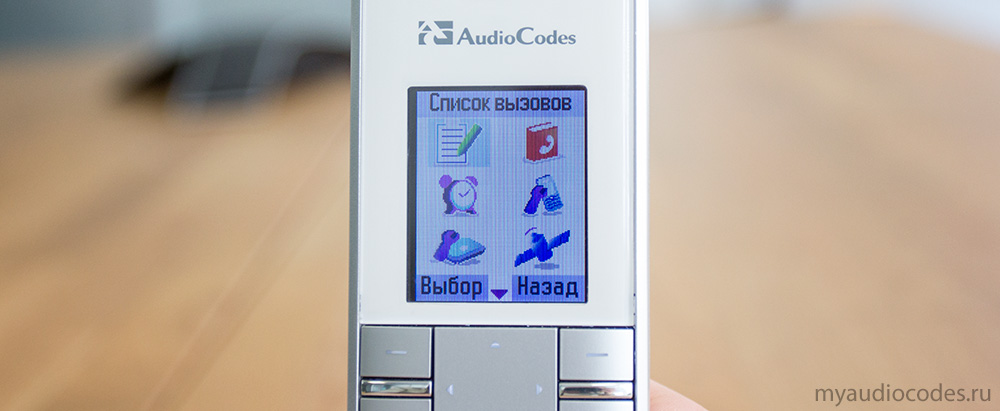
Of the additional useful features there is support for external USB drives for organizing a file server and support for USB printers, as well as for publishing them on a local network (LPD / IPP). The file server can be organized on an external drive formatted in FAT32 or NTFS. For advanced administration features, in addition to the web interface, there is a command line via Telnet and an SNMP agent.

IP-telephony is increasingly becoming a part of our lives and it was obvious that this technology will enter the mass market at a very fast pace. The AudioCodes Router multiservice router demonstrates that organizing a small office with all the attributes is easy: one device replaces the router on the Internet, PBX, allows you to organize a backup channel to the Internet via 3G / 4G, as well as make the file storage and old printer network, and built-in DECT support will make it possible to get rid of some unnecessary wires. Do not forget about the experience of AudioCodes in IP-telephony, this guarantees high compatibility even at a very modest cost.

Manufacturers try to keep up with the trends and strive to make life easier for users, which is why interesting solutions are beginning to appear on the market that focus on the SOHO sector and allow organizing all office communications in one place without any problems. We’ll talk about one of the devices that is able to replace the Internet center of the office (or supplement it).
The issue of equipping the office with telephones can be solved in several ways: connecting a landline telephone, equipping employees with mobile phones and IP-telephony. The first method, as a rule, is the most inflexible: modest functionality and loss of numbers when moving; the second is good as an auxiliary, and the third, IP-telephony, with all its advantages, many do not know "how to cook." Indeed, if you connect a conditional wireless router and establish the Internet is a task that most people with a basic understanding of the essence will cope with, then the task of establishing office telephony will seem difficult for an unprepared person. This is because until recently, such equipment was made taking into account customization by a professional, but market trends are such that manufacturers break existing stereotypes. Of course, the “sophisticated” equipment has not gone anywhere, but it remains the prerogative of large companies with expanded functional needs. But the small business market SOHO / SMB requires engineering simple and easy-to-use solutions.

One of these is the AudioCodes Router series of multiservice VoIP routers , in our case, the MP-272DB model , which is also distributed under the Megafon R2 brand . First of all, it is designed to comprehensively replace or supplement the office's Internet center.
As they say, it's easier to see once:
Technically, this is a combination of a classic wireless router with a PBX with a built-in DECT base and two analog ports for connecting ordinary phones. The device can be connected to the Internet in three ways: via an ADSL2 + or VDSL line, through classic Ethernet and using a USB modem for 3G / 4G networks. Not all SOHO routers provide this rich functionality. In the event of a sudden lack of an Internet connection through the main provider, the device will automatically switch to the spare channel via the 3G / 4G network.
Structurally, the device is made in a slightly inclined vertical version made of white plastic with black inserts on the sides, on the front panel of which there is a charging cup for the supplied DECT tube.


A number of status indicators are located here, including the status of the system, network connection, WiFi, DECT and others. On the bottom of the back of the device there is a power port, Ethernet ports (one for connecting to the Internet and four for LAN devices), xDSL, FXS with an RJ-11 connector and USB. All antennas are inside, no external. The device looks very attractive and the appearance does not spoil the interior.

The device provides full-time support for working from an external battery, which is purchased separately, which will allow you to not be left without communication in case of a sudden power outage in the room. For this, there is a special connector on the rear panel.

Office users can access the Internet both via a wired connection, for which there are four Fast or Gigabit Ethernet ports on board the device (respectively, 100 or 1000 megabits per second, depending on the model), and using wireless WiFi 802.11b / g / n at speeds up to 300 Mbps (2x2). For the convenience and safety of users, there is support for all common network protocols and solutions: SPI firewall, UPnP, 802.1p / q (VLAN and QoS), multicast (IGMP proxy, snooping), a built-in WiFi access point allows you to organize multiple networks (multiple SSID) and supports WPA / WPA2, WPS, as well as authorization through the browser.
But this is all a description of a typical SOHO router, which is not bad, but still a side feature. Historically, AudioCodes has specialized specifically in IP telephony equipment. The manufacturer went further: in addition to the classic VoIP gateway with two analog FXS ports, the device also has a fully-fledged wireless DECT / GAP base with support for up to five handsets (one in the kit).

The telephony protocol uses widespread SIP over TCP / UDP and its secure version with TLS encryption. Voice codecs are represented by the list: G.711μ / a-law, G.729A / B, G.723.1, G.722 (for HD VoIP), G722.2 (WB-AMR), as well as fax support. DECT, as stated, supports up to five handsets. The built-in PBX supports 5 DECT subscribers, two analog subscribers via FXS ports and up to 10 registered IP phones. Full support for dial plan, hold, transfer, call forwarding and up to two independent tripartite conferences is also present.
Automatic fax supports the T30, T.38 protocols, in addition there are useful Fax2Mail functions for automatically sending faxes to e-mail and Mail2Fax, working in the opposite direction and able to work with attachments of TXT, PDF, DOC, Excel, Power Point formats of various images.
The included DECT handset is also white, has a color display and a loud speaker. It has two replaceable AAA batteries, the charging cup is located directly on the router. In case there is no need to charge the handset on the device, the charging cup is easily separated from the main body, which gives the router more compactness. The handset capabilities are not much different from similar DECT handsets, but convenient call manipulation functionality has been organized here: hold, transfer, conference call.

Of the additional useful features there is support for external USB drives for organizing a file server and support for USB printers, as well as for publishing them on a local network (LPD / IPP). The file server can be organized on an external drive formatted in FAT32 or NTFS. For advanced administration features, in addition to the web interface, there is a command line via Telnet and an SNMP agent.

IP-telephony is increasingly becoming a part of our lives and it was obvious that this technology will enter the mass market at a very fast pace. The AudioCodes Router multiservice router demonstrates that organizing a small office with all the attributes is easy: one device replaces the router on the Internet, PBX, allows you to organize a backup channel to the Internet via 3G / 4G, as well as make the file storage and old printer network, and built-in DECT support will make it possible to get rid of some unnecessary wires. Do not forget about the experience of AudioCodes in IP-telephony, this guarantees high compatibility even at a very modest cost.
